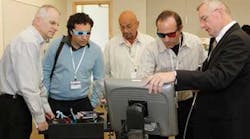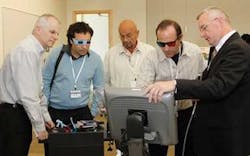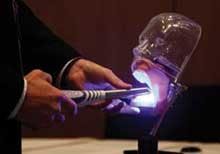by Kevin Henry, Managing Editor
For more on this topic, go to www.dentaleconomics.com and search using the following key words: technology, 3M ESPE, chairside oral scanning, digital dentistry, Kevin Henry.
Talk of technology is nothing new in dentistry. For years, lectures have focused on the next great digital invention and what it will mean to the dental practice and the dentist's bottom line. However, integration and the effect on the practitioner's psyche has rarely been touched upon. Does a dentist truly need to be "digital" to be a "good dentist"? Can digital technology really improve the quality of dental treatments?
These were some of many questions tackled at a recent symposium held at the 3M ESPE headquarters in St. Paul, Minn. Titled, "Transforming Dentistry with Digital Technology," approximately 130 international dental professionals representing more than 40 countries converged at the 3M Innovation Center to share experiences and discuss dentistry's future driven and enabled by digital technology.
Featuring presentations by industry–leading clinicians and 3M ESPE experts, the symposium focused on how future digital workflows will transform current clinical processes.
"While we're excited about the future, we can't forget about the transition to get to where we are going," said 3M ESPE Division Vice President and General Manager Jeff Lavers. "There isn't just one way to do something. We have to explore all of the different ways we can make a patient's life better. We also need to ask ourselves if we are truly prepared to be agents of change. Change is not the issue — how we manage that change is what will define the future of dentistry."
During the symposium's two days, a select group of industry–leading clinicians shared their expertise in various topics from traditional and digital impressions to digital workflow options involving CAD/CAM systems.
Throughout the exploration of current and future workflow solutions, one thing was clear — digitization in dentistry is moving forward and there is a great deal of excitement about the possibilities.
"We discussed very important future changes in dentistry and learned a lot from each other's opinions, which I think has opened each of our minds to the possibilities," said Symposium Co–Chairman Dr. Reinhard Hickel.
Dr. Dennis Fasbinder, director of the Advanced Education in General Dentistry Program and a clinical professor in the Department of Cariology, Restorative Sciences and Endodontics at the University of Michigan School of Dentistry, continued, "The collaboration that we've gotten, the new perspectives on where things are going that we don't get working by ourselves is truly exciting; we've gotten to see what other people are working on and have developed an understanding of how it might fit into what we are pursuing."
During the symposium, speakers presented their own perspectives on digital dentistry, the important role of education in dental schools, utilizing digital technologies today, and more.
Digital impressions received a great deal of attention and excitement, with Dr. János Rohály of Brontes Technologies, a 3M subsidiary, taking the lead in discussing the newer technology behind the Lava™ Chairside Oral Scanner (C.O.S.). As part of several sessions, Dr. Rohály fielded many questions from attendees about the current capabilities of the device, as well as the future applications.
Several current users of the Lava C.O.S. expounded on their own experiences with it, including Dr. Gerard Kugel of Tufts University who shared some of his clinical research. By the end of the Symposium, it was clear that digital impression–making had reinvigorated the attendees about dentistry and digital workflow.
Another popular topic of discussion was materials science, especially zirconia. Attendees agreed that digital technology has made it possible to utilize materials, like zirconia, that they otherwise wouldn't be able to use.
"I showed through my research that all zirconia are not alike and that various manufacturers have shown differences in their materials; that's an important message to get out into the industry," said Dr. Susanne Scherrer, senior lecturer, Department of Prosthodontics, University of Geneva School of Dental Medicine.
In what proved to be a very active discussion, a panel of five leading clinicians was asked to answer the question, "How will digital technology and 3–D display transform dental treatment in the next five years?" After each clinician offered a personal answer, the floor was opened for questions and comments and a nonstop 90 minutes of discussion pursued.
While not all attendees were in agreement with each other, the tone of the discussion was open, spirited, and positive. Throughout the discussion, attendees voiced opinions about the current transformation to digital dentistry. Future applications of the Lava C.O.S. was one of the more lengthy topics discussed.
The human element and practicing ever better dentistry remained an important part of the discussion. In one of the more poignant moments of the discussion, one of the panelists remarked on the paradigm shift that digital dentistry is bringing about.
"We can't just plug in the new technologies and do everything the way we've always done them," said Dr. Fasbinder. "There is a shift here."
In addition to the multitude of educational experiences, current viewpoints were collected and shared utilizing a real–time survey tool. As questions were asked and answered, attendees received an interactive view of how their colleagues viewed digital dentistry. Improvements in precision/quality of restorations, improvements in process quality, and improvements in patient comfort were the highest–ranking motivators for investing in new technologies.
With 130 leading clinicians gathered, there was a great deal of opportunity for shared learning from country to country, and culture to culture. This type of collaboration was evident in all aspects of the symposium, as well as in the frame of mind that attendees brought to the meeting.
Digital dentistry is moving forward, materials science is still of major importance, and when clinicians and industry come together the future for dentistry is bright.
"We hope the attendees have become energized, not just about digital technologies, but about dentistry as a whole," said 3M ESPE's Dr. Gerhard Kultermann.
For more information about the Espertise Global Symposium, go to www.3MESPE.com/symposium.








